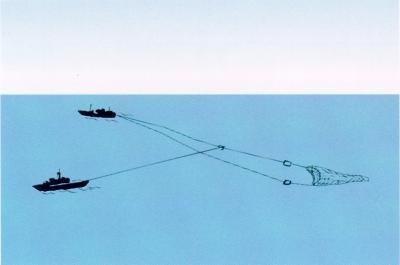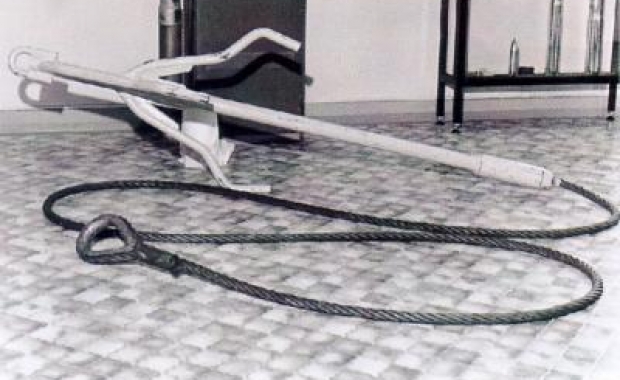The trawling wire cutters are Iceland's most important, if not only, contribution to the arsenal of weapons, a top secret weapon which ensured Iceland's victory in the Cod Wars, a series of conflicts between Iceland and the UK over fishing rights in Icelandic waters in the post-war period.
The design of the cutters was a closely guarded secret during the Cod Wars, and Coast Guard vessels took great care to hide the cutters before coming to harbor to ensure the public, and especially the English, remained in the dark.
The net cutter were invented by the commander of the Icelandic Coast Guard in the 1950s, but first deployed in 1972. The design of the cutters was kept a closely guarded secret, as they were Iceland's most effective weapon against UK trawlers who fished inside what Iceland had proclaimed its exclusive economic and fisheries zone.
The first deployment of the cutters on September 5 1972 proved that the Icelandic Coast Guard could enforce the law and protect Icelandic waters from foreign poachers and illegal fishing.
Secured victory victory over UK in the Cod Wars

The cutters had been invented during the 1958-61 Cod War between Iceland and the UK, caused by Iceland's 1958 declaration that foreign vessels were banned from fishing within a 12 nautical mile exclusive fisheries zone around Iceland. The cutters were not deployed during this conflict, waiting until the 1972-3 Cod War, which followed Iceland's expansion of its exclusive economic zone to 50 nautical miles, and then again during the 1975-76 conflict following the expansion of the EEZ to 200 nautical miles. The design of the wire cutters remained a closely guarded secret throughout the conflicts. H, ultimately ensuring Icelandic victory over the UK.
The cutters are a form of a 2 meter (7 ft) long hook with four knife-like arms which are dragged across trawling wires pulling nets, cutting the wires and thus the entire trawl, causing the fishing vessel to lose not only its entire catch, but also the expensive equipment. After the Icelandic Coast Guard began systematically cutting the wires of British trawlers in Icelandic waters the UK deployment of the Royal Navy in Icelandic waters received added urgency, as UK warships attempted to protect trawlers from the faster Icelandic Coast Guard vessels.
The trawling wire cutters are Iceland's most important, if not only, contribution to the arsenal of weapons, a top secret weapon which ensured Iceland's victory in the Cod Wars, a series of conflicts between Iceland and the UK over fishing rights in Icelandic waters in the post-war period.
The design of the cutters was a closely guarded secret during the Cod Wars, and Coast Guard vessels took great care to hide the cutters before coming to harbor to ensure the public, and especially the English, remained in the dark.
The net cutter were invented by the commander of the Icelandic Coast Guard in the 1950s, but first deployed in 1972. The design of the cutters was kept a closely guarded secret, as they were Iceland's most effective weapon against UK trawlers who fished inside what Iceland had proclaimed its exclusive economic and fisheries zone.
The first deployment of the cutters on September 5 1972 proved that the Icelandic Coast Guard could enforce the law and protect Icelandic waters from foreign poachers and illegal fishing.
Secured victory victory over UK in the Cod Wars

The cutters had been invented during the 1958-61 Cod War between Iceland and the UK, caused by Iceland's 1958 declaration that foreign vessels were banned from fishing within a 12 nautical mile exclusive fisheries zone around Iceland. The cutters were not deployed during this conflict, waiting until the 1972-3 Cod War, which followed Iceland's expansion of its exclusive economic zone to 50 nautical miles, and then again during the 1975-76 conflict following the expansion of the EEZ to 200 nautical miles. The design of the wire cutters remained a closely guarded secret throughout the conflicts. H, ultimately ensuring Icelandic victory over the UK.
The cutters are a form of a 2 meter (7 ft) long hook with four knife-like arms which are dragged across trawling wires pulling nets, cutting the wires and thus the entire trawl, causing the fishing vessel to lose not only its entire catch, but also the expensive equipment. After the Icelandic Coast Guard began systematically cutting the wires of British trawlers in Icelandic waters the UK deployment of the Royal Navy in Icelandic waters received added urgency, as UK warships attempted to protect trawlers from the faster Icelandic Coast Guard vessels.







